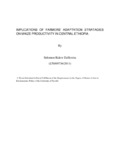| dc.description.abstract | In Sub-Saharan Africa, the capacity of smallholder farmers to adopt climate change adaptation strategies is limited. It is therefore imperative to identify and analyze factors that determine the adoption capacity of these farmers. Using household and plot level data from 898 smallholder farmer households in central Ethiopia, this study identified the major climate change related risk factors faced and the adaptation strategies used by those farmers to minimize the adverse effect of the risks on their crop yields. It also analyzed factors that determine the capacity of these farmers to adopt / choose from various climate change adaptation strategies and estimated the impact of the strategies on households´ maize productivity. Descriptive statistics and three econometric models namely binary logit, Multinomial logit (MNL) and Endogenous Switching regression (ESR) models were used to analyse the data. The findings from the descriptive statistics indicated that drought and flood were the major climate change related risk factors faced by the sampled households, and planting fitting seed varieties, soil and water conservation, crop choice, early or late planting and increasing seed rate were the major adaptation strategies used by those households to cope with the negative effects of the risk factors. The majority (about 52%) of the sampled households did not use climate change adaptation strategy in any of their crop farms. The results of the binary logit model indicated that farmers´ decisions to adopt any yield related climate change adaptation strategy was influenced by climate information, size of livestock, household heads’ formal education level, soil fertility, experience to past drought and flood incidences, the type of risk factor faced, confidence on the skills of government extension workers, market and credit access, kinship, and membership to farmers groups found in the village. The MNL model showed that the direction and magnitude of determining factors varied across adaptation strategies, and farmers´ decision to choose from various climate change adaptation strategies was influenced by the type of risk factor they faced. Actual and counterfactual analysis built from the ESR model indicated that adoption of climate change adaptation strategies improved farmers´ maize productivity, and famers who did not adopt any strategy if they adopted would benefit more than those who actually adopted. Generally, while adoption of climate change strategies helps farmer households to enhance their maize productivity, various constraints that include lacks of education, climate change information, market and credit facility and social capital hindered the majority of farmers in central Ethiopia from adopting any climate change adaptation strategy in any of their maize farms. Therefore, policies should focus on improving access to education, information, market and credit facility, and should encourage informal social networks that can promote group discussions and better information flows and experience sharing | en_US |

